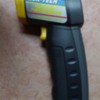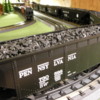I often thought about adding a normally closed heat sensor to the side of the motors in my engines that do heavy pulling on their own. The power from the pick-up rollers would pass through the sensor. That way, if the motor temperature shot up the sensor would open, killing power to the board and preventing damage to the motor. I would also lock the engine in conventional neutral so that when the sensor cooled down and power was restored, the engine wouldn't take off. A switch to bypass the sensor would also come in handy to eliminate the sensor, when running the engine in a MU lash-up, where the chances of over heating would be minimal. The safe operating temperature range would be the tricky part of the project though. I thought of running the engine with the shell off so that I can take temperature readings each time the engine passed by using an infrared thermometer, adding cars until the motor "started" getting that hot smell.  Any thoughts?
Any thoughts?
Replies sorted oldest to newest
By the time the motor gets that hot, the motor drivers may be on their deathbed. It's not just the motor you have to worry about.
John, I would purchase a sensor that would open before damage could result, not after the damage is done. The question would be what that temperature would be. At least you would know what the temperature of the motor is, when damage is starting to occur, by the smell. Then I would order a sensor below that temperature by 20 percent.
A little engineering math....during the development of a solid state e unit, testing showed the stall current for a two motor [Mabuchi] plastic diesel to be 4.1 amps at 12V. Deducting the insertion loss of two triacs or power mosfets [2 x 1.4V for a pnpn junction device] you have 9.2V times 4.1 amps or 36.8 watts of power. This could generate any range of temperatures depending upon if you are in a cool basement up north or a hot garage in Florida and whether you have a smoke unit running full tilt inside you plastic shelled diesel.
Skip the math; refer to GRJ above.
Lou N
If I had this heating problem, I would not put the sensor in the circuit of the motor current, I would put an appropriate rated relay in that motor circuit. I would use a thermistor located to monitor the temp and have it latch the relay. The latched relay would keep the motor current shut off until I investigate the situation. A reset switch or a loss of power to the circuit would easily unlatch the relay. Even better if you could thermally attach the case of the motor to the chassis and use the moving chassis to help dissipate the heat.
I have only seen a couple of motors cooked by overheating, but I've seen a ton of motor drivers blown from overload, I'd want to monitor that if I monitored anything.
I just don't try to pull the most amount of cars with the least amount of motive power...
In over 50 years in the hobby, I haven't lost a motor yet.
Rusty
The thought of a heat sensor for motor protection came to me, when I came back to the hobby, about 7 years ago. I was pulling 22 empty coal hoppers with a Rail King PRR 2-8-0. After about 10 laps I began to smell the motor getting hot. The hoppers were all brand new and I should have oiled the axles before running them. I was just too excited to see a long train, with matching cars, run on the layout. After oiling all the axles it never got hot again. I think back that if I didn't smell that motor and get it shut down in time, that engine would have been toast. I could understand motor drivers blowing from current overload, but wouldn't the current draw be the same on the first lap as it would on the 10th lap? Will a motor that is gradually increasing in temperature cause the current draw to also increase?
Dave Zucal posted:...but wouldn't the current draw be the same on the first lap as it would on the 10th lap? Will a motor that is gradually increasing in temperature cause the current draw to also increase?
Although the current draw may be the same the electronics (which starts at room temperature when you first turn it on) heats up over time and eventually some semiconductor junction in a motor driving transistor overheats and fails somewhere above 150C. If the current draw is low then the electronics warms up but not enough to fail. Obviously the circuit should be designed so that under nominal conditions, the electronics stays at a safe operating temperature.
The motor is doing the same thing. It starts at room temperature and even if pulling a constant load, the motor heats up over time. There are complex interactions. For example, as the motor warms up the motor windings increase in electrical resistance meaning less current flows which means less torque/speed. But if you have a speed control the electronics will compensate by increasing motor current to maintain speed. Likewise, when the magnets in the motor get hot, they become less efficient and, again, if you have speed control the electronics will increase current to compensate. So more power is delivered into the motor case, it warms up that much more, and away we go!
To your experience by the time you get some engineers to do the math to figure out an overload detection method, you might as well use your nose. ![]()
Seriously though, I see nothing wrong with using a thermal cut-off sensor to cut power to the motor when it overheats. For example the motor in my paper shredder has one if I try to shred too many sheets in a short amount of time. Wait a few minutes for the motor case to cool down and I'm back in business.
You should be able to find a suitable cutoff switch that can be mounted to your motor for less than $1. Problem is coming up with a trip temperature since it depends on many design factors. Here's an eBay listing where you choose the temperature in 5 degree increments.
Actually, I've wondered why O-gaugers don't put in a $1 thermal cutoff switch for smoke units. You read so often about shells warping or melting because the smoke unit ran hot for whatever reason.
Attachments
Thank You everyone for your great input. My engines will be working hard on my layout moving coal loaded hoppers from a coal mine and breaker area at one end of the layout to a double siding located at a power plant at the other end. The layout platform will be shaped like the Greek letter for Pi. The top of the Pi symbol is 48'. The legs of the symbol 22' each. A double mainline will follow the outer perimeter of the Pi symbol. The plant will be modeled after the Hauto PP&L power plant which was a top loading plant using hopper cars. It once stood a few miles from me here in PA. One siding will be for the loaded train to be dropped and the other siding will be for empties to be picked up and taken back to the breaker. At the power plant a switcher (I would love to find a blue stream line PP&L switcher, if one was ever made) will take one car at a time up a ramp and push it into the top floor of the plant to be emptied. You can see the curved ramp and bridge connecting the plant in the photo. The same coal that is emptied into the power plant will move via hidden conveyor 42' back to the breaker and come out of the breaker into a waiting empty hopper car.
Getting back to the sensors, a second choice and more logical, would be to install normally open sensors that when activated will illuminate a bright, red, blinking LED, mounted in the cab of each engine, where it would be visible as a warning that the temperature is approaching the danger zone. After reading GRJ's post, I believe both the motors and the motor drivers heat should be monitored with a sensor.
I do realize most operators do not heavy haul or need this warning protection. This is mainly for my personal application and enjoyment. My sidings will be capable of holding 40 hopper cars. My goal will be to achieve moving 40 loads of coal to the power plant. Helpers will be used. The sensors will help in determining how many helpers will be needed to make the run. I can build the breaker a few inches higher than the power plant to give me a slight down hill grade all the way to the siding at the plant. Then push and
 pull the empties up the grade back to the breaker.
pull the empties up the grade back to the breaker.
Attachments
Well, I never...just what are you pulling with these wee locomotives?
Attachments
Dave, this is an interesting idea, but I would monitor the temperature of the motor driver devices, not the motor itself.
As GRJ pointed out, the driver transistors will fail before the motor does.
Rich, I did mention in my post above, after GRJ's advice, that it would be best to monitor the heat from both the motors and the drivers. For what the sensors cost and the easy installation, it would make for a fun project. Once my track is laid I'll be able to run some test and record some temperatures of these components.











